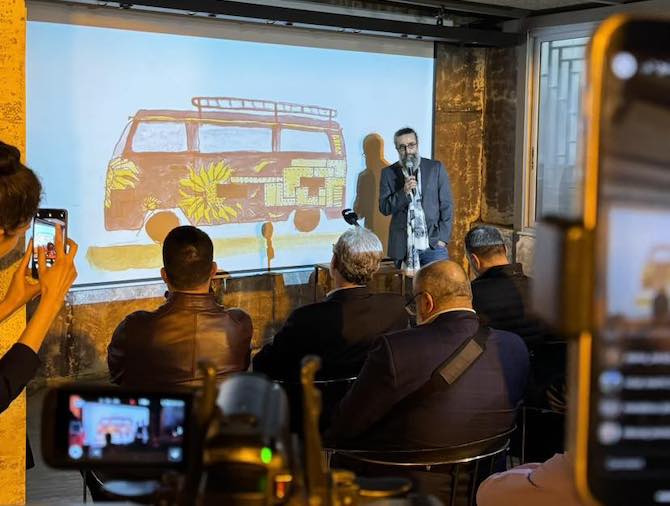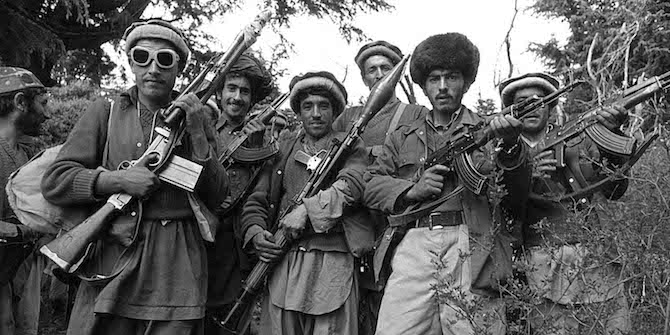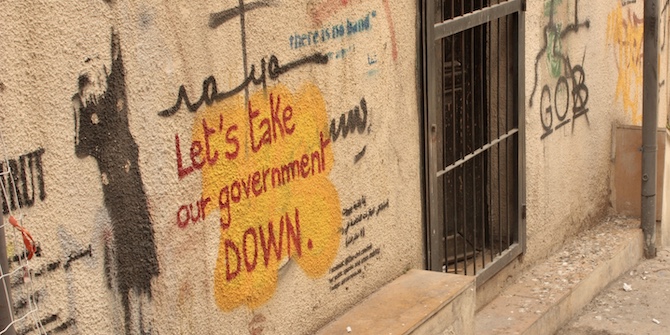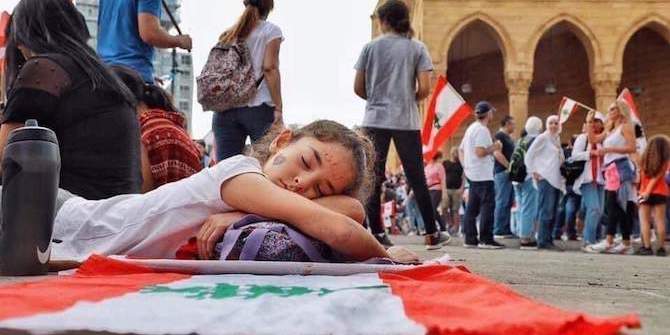by Anne Kirstine Rønn

In Lebanon, professional syndicates[1] are not merely representative organs for occupations like lawyers, doctors, and engineers. They are also political battlegrounds between traditional sectarian parties and challengers with roots in civil society and popular anti-establishment protests. While challengers seek to gain ground in syndicate council elections, the parties put their rivalries aside and form wide alliances to remain in power.
Some of the most significant electoral battles have occurred in the Order of Engineers and Architects (OEA), one of the largest professional syndicates in Lebanon with over fifty thousand members. The OEA is divided into two entities: ‘the North’, covering Tripoli and Akkar, and ‘Beirut’, which covers all other Lebanese regions. Challengers for office have won significant victories in recent years, especially in Beirut.
In 2017, Jad Tabet won the election for the head of the OEA as part of a coalition of called ‘Naqabati’ (My Order). The coalition had its roots in a popular protest movement, formed in response to a severe waste management crisis in 2015. Many of its organisers had also been involved in Beirut Madinati (Beirut, My City), a grassroots campaign that challenged the established parties in Beirut’s 2016 local elections.
In 2021, the challengers expanded their power within the OEA. Under the banner ‘al-Naqaba Tantafid’ (The Order Revolts), a coalition of more than 20 groups ran as representatives of the October Uprising, which had mobilised around a million citizens against the ruling elites in 2019. The Order Revolts gained 65.6 percent of the vote and secured the position of head of OEA Beirut. This landslide victory was credited as an important achievement of the October Uprising and led observers to suggest that syndicate elections could be a stepping stone for oppositional forces trying to gain power in Lebanon’s national political scene. However, recent elections in the OEA have represented a setback for these forces, demonstrating how difficult it is to hold on to power when faced by alliances of sectarian parties that seek to regain their influence.
The main coalition running against the sectarian parties in this year’s elections in OEA Beirut was Musammimoon (meaning both ‘determined’ and ‘designers’), which presented itself as a revival of The Order Revolts. Yet, despite being backed many well-known groups and activists, expectations for the coalition were limited. In 2023, when Musammimoon ran for the first time, they won a single seat out of the five they contested[2] for the OEA Beirut’s central council, while the remaining seats went to an alliance of candidates linked to the Amal Movement, Hezbollah, the Future Movement and the Free Patriotic Movement.
Moreover, since their victory in 2021, challengers have struggled to achieve results amidst the spiralling economic crisis and political deadlock. Meanwhile, internal divisions had led the Order Revolts coalition to become increasingly fragmented. This was evident in the recent elections, where Musammimoon faced competition from a former candidate for The Order Revolts, Joseph Mshaileh, who ran under another campaign for the post of head of the OEA.
This year’s elections consisted of two rounds. In the first on 10 March 2024, members of OEA elected different representatives[3] and delegates for the syndicate’s seven branches, which include different professional sub-categories such as those for Mechanical Engineers and Architects. 313 seats were contested, and Musammimmoon achieved victories for 26 out of the 43 candidates on their list. This offered some hope that the coalition might regain some momentum.
In April’s second round, the focus was on electing new members of the OEA’s central council (comprised of 16 members, including the naqeeb, or head of the syndicate) as well as a new leader of the organisation. Musammimmoon’s candidates lost,[4] and the leadership post went to Fadi Hanna, who was supported by an alliance of the Christian Free Patriotic Movement, the so-called ‘Shia duo’ consisting of the Amal Movement and Hezbollah, as well as a smaller Islamic grouping called Al-Ahbash.
These election results showcase how Lebanon’s sectarian elites are managing to remain in power, despite endemic corruption, political mismanagement, and in spite of their role in the devastating economic crisis and the Beirut Port explosion. The strategies of clientelism, kinship ties and intimidation have proven to continue to be remarkably efficient, and elites have used these to co-opt the country’s civic and associational life since the end of the civil war. Moreover, the results show how challengers still struggle to present a strong alternative to the sectarian parties amidst internal divides and strategic challenges.
Still, the setback of challengers in the OEA does not change the fact that syndicates are an important arena for actors seeking to limit the power of sectarian parties in Lebanon. Syndicates organise tens of thousands of citizens drawn from the more well-educated and resourceful segments of the population. Compared to trade unions, which have been abandoned by a large part of the Lebanese workforce,[5] they have a substantial membership ratio, as syndicate membership as a requirement to practice professions such as law and engineering.
Moreover, syndicate elections play a significant role for the sectarian parties. This is reflected in the way Gebran Bassil, leader of the Christian Free Patriotic Movement, framed the OEA elections as the end of an ‘interminable plot’ to eliminate his party. The fact that the Shia Amal Movement backed his preferred candidate also marks a rapprochement between two parties with a historically tense relationship. Bassil’s victory rhetoric and the improved relations between his party and the Amal Movement will likely be used as assets in the upcoming municipal elections, another battle between the forces of change and the status quo, which (despite rumours of postponement) remain set for later in 2024.
[1] Lebanon’s professional syndicates (naqabāt), also called professional unions or ‘free profession’ unions are similar to guilds. Their formal goals are to ensure the interests of members and determine the terms of membership in order to protect the profession. They are also regulated by a unique set of laws, which are different from those governing trade unions. See Mouawad, J. (2021). Lebanese Trade Unions and Independent Professional Associations: A Review in Light of the Popular Movement. Arab Reform Initiative
[2] The contested seats were: 1) the presidency of the Architects’ branch, 2) the presidency of the sixth branch, and 3) the last three seats of the General Assembly.
[3] Each branch has its own council, which consists of a president and a number of delegates who are divided into three categories according to the number of years of membership. In addition to these delegates, OEA members also elected 5 representatives for branch 1 and 7. In the second round, on April 14, registered engineers and architects then voted for one of these five representatives to represent their branch in the central council of the OEA.
[4] Musammimoon’s candidate for head of syndicate, Roy Dagher, was already a member of the OEA Beirut’s main council and maintains this position
[5] In 2020, only 5–7 % of the Lebanese population were members of trade unions, as compared to 22.3 % in 1965. Source: Lea Bou Khater, The Labour Movement in Lebanon: Power on Hold (Manchester: Manchester University Press, 2022).






